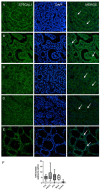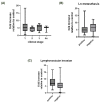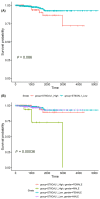Role of ST6GAL1 in Thyroid Cancers: Insights from Tissue Analysis and Genomic Datasets
- PMID: 38003522
- PMCID: PMC10671354
- DOI: 10.3390/ijms242216334
Role of ST6GAL1 in Thyroid Cancers: Insights from Tissue Analysis and Genomic Datasets
Abstract
Thyroid cancer is the predominant endocrine-related malignancy. ST6 β-galactoside α2,6-sialyltransferase 1 (ST6GAL1) has been studied in various types of cancers; however, the expression and function of ST6GAL1 in thyroid cancer has not been investigated so far. Previously, we conducted two genome-wide association studies and have identified the association of the ST6GAL1 gene with plasma thyroglobulin (Tg) levels. Since Tg levels are altered in thyroid pathologies, in the current study, we wanted to evaluate the expression of ST6GAL1 in thyroid cancer tissues. We performed an immunohistochemical analysis using human thyroid tissue from 89 patients and analyzed ST6GAL1 protein expression in papillary thyroid cancer (including follicular variant and microcarcinoma) and follicular thyroid cancer in comparison to normal thyroid tissue. Additionally, ST6GAL1 mRNA levels from The Cancer Genome Atlas (TCGA, n = 572) and the Genotype-Tissue Expression (GTEx) project (n = 279) were examined. The immunohistochemical analysis revealed higher ST6GAL1 protein expression in all thyroid tumors compared to normal thyroid tissue. TCGA data revealed increased ST6GAL1 mRNA levels in both primary and metastatic tumors versus controls. Notably, the follicular variant of papillary thyroid cancer exhibited significantly higher ST6GAL1 mRNA levels than classic papillary thyroid cancer. High ST6GAL1 mRNA levels significantly correlated with lymph node metastasis status, clinical stage, and reduced survival rate. ST6GAL1 emerges as a potential cancer-associated glycosyltransferase in thyroid malignancies, offering valuable insights into its diagnostic and prognostic significance.
Keywords: ST6GAL1; follicular thyroid cancer; follicular variant of papillary thyroid carcinoma; microcarcinoma; papillary thyroid cancer.
Conflict of interest statement
The authors declare no conflict of interest.
Figures



Similar articles
-
Expressions of human sodium iodide symporter mRNA in primary and metastatic papillary thyroid carcinomas.Thyroid. 2000 Mar;10(3):211-7. doi: 10.1089/thy.2000.10.211. Thyroid. 2000. PMID: 10779135
-
Spatial single-cell maps reveal ST6GAL1 promoting ovarian cancer metastasis.Glycoconj J. 2025 Feb;42(1):27-40. doi: 10.1007/s10719-025-10177-y. Epub 2025 Jan 30. Glycoconj J. 2025. PMID: 39883364
-
Epigenetic inactivation of ST6GAL1 in human bladder cancer.BMC Cancer. 2014 Dec 2;14:901. doi: 10.1186/1471-2407-14-901. BMC Cancer. 2014. PMID: 25465919 Free PMC article.
-
Follicular cell thyroid neoplasia: insights from genomics and The Cancer Genome Atlas research network.Curr Opin Oncol. 2016 Jan;28(1):1-4. doi: 10.1097/CCO.0000000000000248. Curr Opin Oncol. 2016. PMID: 26569424 Review.
-
Papillary thyroid carcinoma variants.Head Neck Pathol. 2011 Mar;5(1):51-6. doi: 10.1007/s12105-010-0236-9. Epub 2011 Jan 8. Head Neck Pathol. 2011. PMID: 21221869 Free PMC article. Review.
Cited by
-
Expression patterns and diagnostic efficacy of cytokeratin 19 and galectin-3 in thyroid neoplasms.Int J Clin Exp Pathol. 2025 Jun 15;18(6):233-244. doi: 10.62347/TZNW3776. eCollection 2025. Int J Clin Exp Pathol. 2025. PMID: 40642392 Free PMC article.
References
MeSH terms
Substances
Grants and funding
LinkOut - more resources
Full Text Sources
Medical
Molecular Biology Databases
Miscellaneous

